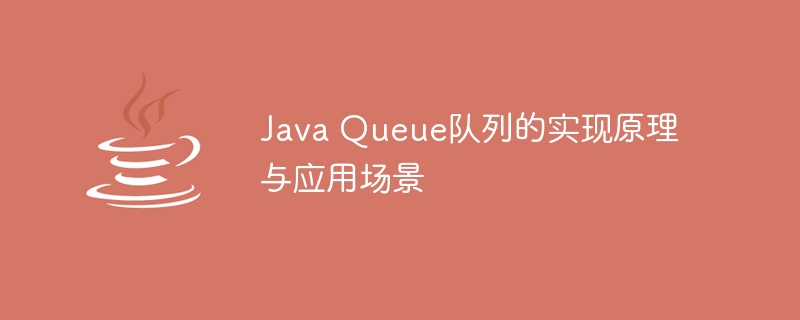Home >Java >javaTutorial >Detailed explanation of the working principle of Java Queue and its applicable scenarios
Detailed explanation of the working principle of Java Queue and its applicable scenarios
- 王林Original
- 2024-01-13 11:07:051438browse

Implementation principles and application scenarios of Java Queue
1. Introduction
In software development, queue is a common data structure. It inserts and deletes elements according to the first-in-first-out (FIFO) principle. Java provides the Queue interface, which defines the basic operations of the queue, such as entering the queue, dequeuing, and obtaining the first element of the queue.
This article will introduce the implementation principle of Java Queue and its application scenarios, and give specific code examples.
2. Implementation Principle
The implementation class of Java Queue interface usually takes the form of an array or linked list. The two implementation principles are introduced below:
- Array implementation principle
The array is a linear structure, and elements can be accessed through subscripts. For the implementation of the Queue interface, you can use the circular array method, that is, define two pointers at the head and tail of the array to point to the head and tail of the queue respectively. During the enqueuing operation, the element is first inserted into the tail and the tail pointer is moved backward. When the dequeuing operation is performed, the head element is first taken out and the head pointer is moved backward.
The implementation of this method is simple and efficient, but the expansion of the array needs to be considered. When the number of elements in the queue exceeds the length of the array, a larger array needs to be created and the elements of the original array are copied to in the new array.
- Linked list implementation principle
A linked list is a data structure composed of nodes. Each node contains a data element and a pointer to the next node. For the implementation of the Queue interface, you can use a doubly linked list, that is, each node in the linked list contains pointers to the previous node and the next node.
When enqueuing, you need to create a new node and insert it at the end of the linked list. When dequeuing, you need to find the head node of the linked list and delete it.
The implementation of linked list is more flexible than the implementation of array. It can dynamically add or reduce nodes without considering the issue of array expansion. However, linked lists require additional space to store pointers and occupy relatively large memory space.
3. Application Scenarios
Queue queue has many scenarios in practical applications. Here are some common scenarios as examples:
- Message Queue
In distributed systems, message queues are widely used in scenarios such as decoupling, asynchronous processing, and traffic cutting. The producer sends messages to the queue, and the consumer takes the messages from the queue and processes them. The first-in-first-out feature of the queue ensures that messages are processed in the order they are sent.
Sample code:
import java.util.Queue;
import java.util.LinkedList;
public class MessageQueue {
private Queue<String> queue;
public MessageQueue() {
this.queue = new LinkedList<>();
}
public void enqueue(String message) {
queue.add(message);
}
public String dequeue() {
return queue.poll();
}
public boolean isEmpty() {
return queue.isEmpty();
}
public int size() {
return queue.size();
}
public String peek() {
return queue.peek();
}
}- Thread pool task queue
The thread pool is used to manage the execution of multiple threads. When the threads in the thread pool are not When idle, new tasks can be put into the task queue to wait for execution. Through the characteristics of the queue, it is ensured that threads are executed in the order in which tasks are submitted, which increases task controllability.
Sample code:
import java.util.Queue;
import java.util.LinkedList;
public class ThreadPool {
private Queue<Runnable> queue;
public ThreadPool() {
this.queue = new LinkedList<>();
}
public void addTask(Runnable task) {
queue.add(task);
}
public void execute() {
while (!queue.isEmpty()) {
Runnable task = queue.poll();
new Thread(task).start();
}
}
}- Breadth First Search Algorithm (BFS)
The BFS algorithm is often used in scenarios such as graph traversal and shortest path search. In the BFS algorithm, a queue needs to be used as an auxiliary data structure, and the traversed nodes are added to the queue in sequence and traversed in a first-in, first-out order.
Sample code:
import java.util.Queue;
import java.util.LinkedList;
public class BFS {
public void bfs(Node start) {
Queue<Node> queue = new LinkedList<>();
queue.add(start);
while (!queue.isEmpty()) {
Node node = queue.poll();
System.out.println(node.value);
for (Node neighbor : node.neighbors) {
if (!neighbor.visited) {
neighbor.visited = true;
queue.add(neighbor);
}
}
}
}
}4. Summary
This article introduces the implementation principle of Java Queue and several common application scenarios, and gives specific code examples . As a commonly used data structure, queues play an important role in software development. By using queues appropriately, the efficiency and maintainability of programs can be improved.
By studying the Queue queue, we can better understand the basic principles of data structures and algorithms, and apply them to appropriate scenarios in actual development. I hope readers can have a deeper understanding of Java Queue through this article.
The above is the detailed content of Detailed explanation of the working principle of Java Queue and its applicable scenarios. For more information, please follow other related articles on the PHP Chinese website!
Related articles
See more- In-depth analysis of final implementation principles in Java (with examples)
- 5 common redis application scenarios
- What is the implementation principle of redis distributed lock
- An article explains in detail the implementation principle of golang defer
- Security and application scenarios of digital certificates

